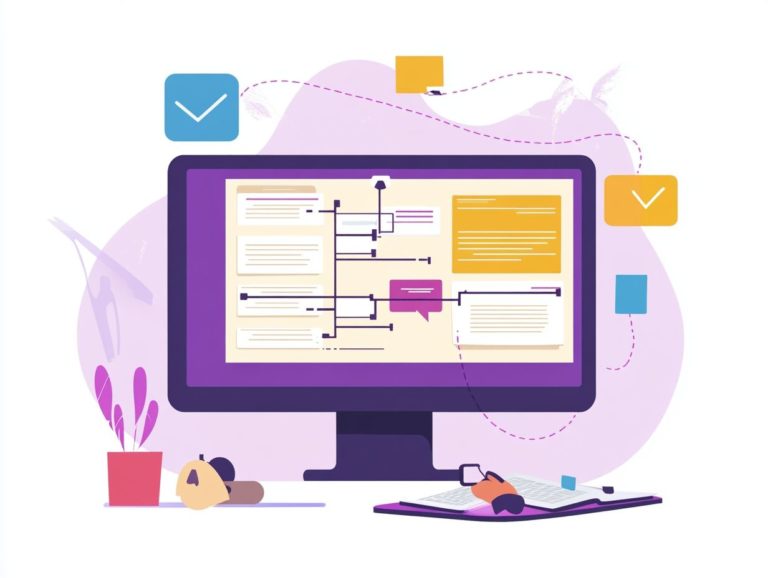The Importance of Stakeholder Communication
In today’s interconnected world, effective stakeholder communication is vital. Whether you’re overseeing a project or leading a business, understanding the needs, expectations, and concerns of your stakeholders can set you apart.
This article highlights the importance of clear communication and identifies key stakeholder groups. It also presents strategies for engaging with them effectively and addresses the complexities of managing challenging stakeholders. Additionally, it offers metrics to assess your communication success.
Dive into these insights and unlock the secrets to engaging your stakeholders like never before!
Contents
- Key Takeaways:
- The Role of Stakeholder Communication
- Identifying Stakeholders
- Effective Communication Strategies
- Managing Stakeholder Expectations
- Dealing with Difficult Stakeholders
- Measuring the Success of Stakeholder Communication
- Frequently Asked Questions
- What is the importance of communication with stakeholders?
- Who are considered stakeholders in a project or organization?
- What are the benefits of regular communication with stakeholders?
- What are some effective methods of communication with stakeholders?
- How can stakeholders be engaged in the communication process?
- What are some consequences of poor communication with stakeholders?
Key Takeaways:

Effective communication with stakeholders is crucial for the success of any project or organization. Understanding the needs and expectations of different stakeholder groups is essential for tailoring communication strategies.
Regularly monitoring and evaluating communication effectiveness can help improve relationships and manage expectations.
The Role of Stakeholder Communication
Stakeholder communication plays a crucial role in project management. It ensures that you engage effectively throughout the project lifecycle.
By being clear and open among stakeholders such as project managers, team members, and sponsors you can streamline project requirements and boost buy-in, which is essential for project success.
Effective communication not only gathers feedback but also helps you understand and address stakeholder needs. This approach can mitigate potential challenges and risks.
Prioritizing stakeholder communication aligns your project objectives with stakeholder expectations, paving the way for successful outcomes.
Understanding the Importance
Understanding the importance of stakeholder communication is crucial for achieving your desired outcomes. Effective communication serves as a bridge between your project teams and stakeholders.
Using clear messaging and tools like regular progress updates fosters an environment of trust and collaboration.
For instance, holding quarterly stakeholder meetings creates an open dialogue. This allows participants to voice concerns and share insights that might otherwise go unheard.
Transparent practices, like sharing project timelines and milestones, enable stakeholders to actively participate and feel invested in the outcome.
These best practices not only address stakeholder needs but also significantly increase the likelihood of your project s success.
Identifying Stakeholders
Identifying stakeholders is an essential step in project management. It requires careful analysis of different stakeholder groups.
By understanding their interests and expectations, you position yourself for greater success and collaboration throughout the project lifecycle.
Key Stakeholder Groups
Key stakeholder groups include project managers, sponsors, team members, customers, vendors, and regulatory agencies. Each plays a critical role in driving project success.
Understanding the different interests of these groups is crucial. Their influence can shape your project s goals.
For example, project sponsors focus on securing a strong return on investment, which may lead to adjustments in budget allocations and timelines.
Customers often emphasize product quality and timely delivery, impacting the scope of deliverables.
Your team members offer valuable insights that can enhance efficiency. Maintaining effective communication ensures their goals align with the project vision.
Vendors influence procurement strategies, while regulatory agencies introduce compliance requirements. Their engagement and feedback are essential for project progression.
By building strong relationships with each stakeholder, you can navigate challenges and guide the project to a successful conclusion.
Start implementing these strategies today to see immediate improvements in your stakeholder relationships!
Effective Communication Strategies

Effective communication strategies are essential for cultivating stakeholder engagement. They ensure that project objectives are achieved with clarity and transparency.
By adopting these strategies, you position yourself to foster collaboration and build trust. Ultimately, this drives the success of your projects.
Tailoring Communication to Different Stakeholders
Tailoring your communication to meet the specific needs of different stakeholders is crucial for encouraging good conversations and promoting collaboration. Recognizing that each group has its unique preferences and expectations can significantly boost engagement and understanding.
For example, while a technical team might thrive on detailed, data-driven presentations, community stakeholders are likely to respond more positively to visual storytelling or simplified reports that spotlight key impacts. Utilizing tools like surveys or feedback sessions enables stakeholders to express their communication preferences, allowing you to adapt your strategies accordingly.
Ultimately, embracing this level of customization not only nurtures relationships but also enhances transparency. When all parties feel valued and heard, it paves the way for more fruitful partnerships.
Managing Stakeholder Expectations
Managing stakeholder expectations is an essential facet of project management. It involves setting realistic goals, communicating progress clearly and confidently, and proactively addressing any concerns stakeholders may have.
By mastering this, you can ensure a smoother project journey and foster a collaborative environment.
Setting Realistic Goals and Communicating Progress
Setting realistic goals and effectively communicating progress to stakeholders is essential for maintaining trust and transparency throughout the project lifecycle. Establish clear timelines and define specific milestones that are both attainable and measurable.
By breaking larger tasks into smaller, manageable parts, stakeholders can easily grasp progress and understand the overall trajectory of the project. Effective communication is pivotal; regular updates and feedback loops help align expectations and uncover any challenges early on.
This proactive approach not only reinforces stakeholder buy-in but also keeps them engaged and invested in the project’s success. This creates a vibrant environment for collaboration!
Dealing with Difficult Stakeholders
Navigating the complexities of difficult stakeholders presents considerable challenges in project management. However, by employing effective strategies, you can foster constructive outcomes and strengthen relationships.
Tips for Handling Challenging Situations

Navigating challenging situations with stakeholders demands effective listening and meticulously crafted communication strategies that address their unique concerns. This approach not only diffuses tensions but also paves the way for a more constructive dialogue.
For instance, imagine a project with diverse stakeholders who have conflicting priorities. One team expertly organized a structured feedback session, allowing everyone to express their views without interruptions. By actively engaging in listening and posing open-ended questions, the project leader identified common goals, steering the group toward a collaborative resolution.
Customize communication by incorporating visual aids or using straightforward language to clarify complex concepts. This thoughtful approach makes stakeholders feel valued and truly understood.
Measuring the Success of Stakeholder Communication
Measuring the success of stakeholder communication is crucial for assessing the effectiveness of the strategies you employ throughout the project lifecycle. This evaluation not only highlights areas for improvement but also ensures that your efforts align with stakeholder expectations and project goals.
After implementing these strategies, it s time to measure their success. Consider how well you addressed stakeholder concerns and how engaged they felt throughout the project.
Implement these strategies in your next project and share your experiences with others!
Key Metrics and Evaluation Methods
Key metrics for evaluating the success of your communication with stakeholders include measuring feedback from them, engagement levels, and how effective they perceive the communication to be.
You can also use both quantitative and qualitative methods to gain a comprehensive understanding of communication dynamics.
- Quantitative measures might include surveys with clear ratings or tracking response times.
- Qualitative approaches could involve in-depth interviews or focus groups that uncover nuanced perspectives.
By effectively utilizing these evaluation methods, you can identify areas for improvement in your communication strategies. This fosters a stronger relationship with stakeholders and contributes to project success, enhancing overall satisfaction among all parties involved.
Frequently Asked Questions
What is the importance of communication with stakeholders?
Strong communication with stakeholders drives success! It helps establish strong relationships, aligns goals and expectations, and promotes transparency and trust.
Who are considered stakeholders in a project or organization?

Stakeholders are individuals or groups with a vested interest in the project or organization and can be affected by its actions or decisions. They can include employees, customers, investors, suppliers, government agencies, and the community.
What are the benefits of regular communication with stakeholders?
Regular communication with stakeholders can lead to improved decision-making, increased support and buy-in, reduced conflicts and misunderstandings, and better overall project or organizational performance.
What are some effective methods of communication with stakeholders?
The most effective method depends on the specific project or organization and its stakeholders. Common methods include in-person meetings, email updates, newsletters, social media, and stakeholder surveys.
How can stakeholders be engaged in the communication process?
You can engage stakeholders by involving them in discussions and decisions, actively listening to their concerns, and providing opportunities for them to share their perspectives.
What are some consequences of poor communication with stakeholders?
Poor communication can lead to a lack of support and trust, delays or failure of projects, damage to the organization’s reputation, and potential legal or regulatory issues.






